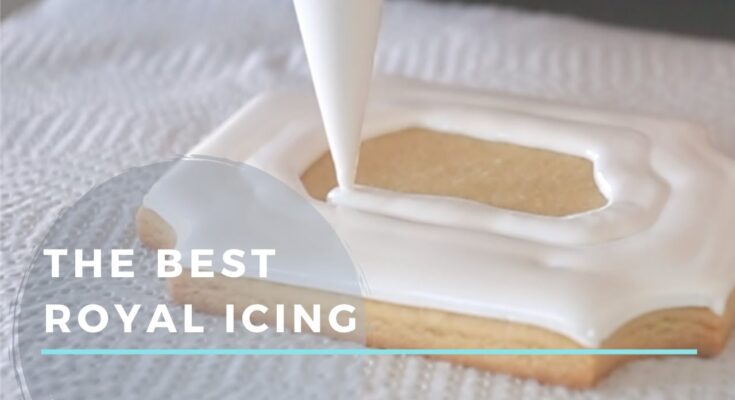Royal Icing Recipe: Royal icing is a classic and versatile icing made primarily from egg whites and powdered sugar. It’s renowned for its smooth finish, fast-drying properties, and ability to hold intricate shapes, making it ideal for decorating cookies, gingerbread houses, and wedding cakes. Unlike buttercream, royal icing dries hard, creating a glossy, flawless surface that resists smudging. Whether you’re a beginner or a seasoned decorator, mastering royal icing opens up endless creative possibilities.
Ingredients Needed for Royal Icing
Creating royal icing requires just a few ingredients, but the proportions and mixing methods are crucial for achieving the right texture.
- Egg Whites or Meringue Powder: Traditionally, royal icing uses raw egg whites, but meringue powder offers a safer, shelf-stable option, making it a favorite among professional bakers.
- Powdered Sugar: Also known as confectioners’ sugar, this finely ground sugar is essential for smooth, lump-free icing.
- Lemon Juice or Vanilla Extract (Optional): Adding a few drops of lemon juice can help cut through the sweetness, while vanilla extract adds a subtle flavor.
- Water: Helps achieve the right consistency for decorating.
Optional Ingredients:
- Food coloring
- Almond or other flavor extracts
Essential Equipment for Making Royal Icing
Creating smooth, beautiful royal icing is easier with the right equipment. While not all tools are essential, they greatly improve your results and ease of use.
- Electric Mixer: A hand mixer or stand mixer is essential for whipping air into the icing for a smooth, stable texture.
- Mixing Bowls: Use clean, dry bowls, as any oil or moisture can affect the icing.
- Sifter: Sifting the powdered sugar before mixing helps prevent clumps in the icing.
- Piping Bags and Tips: Essential for applying the icing to cookies or cakes, with various tips allowing for different designs.
- Spatula: A silicone spatula helps scrape down the bowl and achieve a smooth consistency.
- Storage Containers: Airtight containers prevent the icing from drying out between uses.
Preparation Steps for Royal Icing
Getting your ingredients and workspace ready is key to making smooth, glossy royal icing that’s perfect for decorating.
- Organize Ingredients: Measure out all ingredients before starting to avoid disrupting the mixing process.
- Sift the Powdered Sugar: This step removes any lumps, creating a smoother final icing.
- Prepare Piping Bags: If decorating immediately, prepare piping bags and tips based on your intended designs.
Step-by-Step Guide to Making Royal Icing
Follow these detailed steps for a smooth, beautiful royal icing ready for all your decorating projects.
- Combine Ingredients: In a large mixing bowl, add egg whites (or meringue powder with water) and sifted powdered sugar.
- Start Mixing: Begin mixing on a low speed to combine, then increase to medium speed. Mix until the icing becomes smooth and slightly stiff.
- Adjust Consistency: Depending on your use, adjust the icing by adding small amounts of water (for thinning) or powdered sugar (for thickening).
- Add Flavor: At this stage, add any optional extracts like vanilla or almond, then mix to combine.
- Color (Optional): If using colors, divide icing into separate bowls and add a few drops of gel food coloring.
Consistency Variations for Royal Icing
There are three primary consistencies of royal icing, each suited for different purposes:
- Stiff Consistency: Ideal for creating outlines or intricate designs that require the icing to hold its shape.
- Medium Consistency: This is best for piping borders or details that require slightly more flow without spreading too much.
- Flood Consistency: This thin consistency spreads easily, making it perfect for filling in larger areas or creating a smooth base layer.
Adjusting Royal Icing Consistency
To achieve the right consistency, remember these simple tips:
- For Thinner Icing: Add water one drop at a time, mixing thoroughly. Royal icing thins out quickly, so be cautious.
- For Thicker Icing: Add small amounts of powdered sugar, mixing after each addition to check the thickness.
Avoid common mistakes like over-thinning, as it can make your icing runny and difficult to work with.
Coloring Royal Icing
Coloring royal icing can bring your decorations to life. Gel food coloring is recommended as it provides vibrant hues without affecting the icing’s consistency.
- Divide and Color: Divide the icing into separate bowls if using multiple colors.
- Add Color Gradually: Start with a small amount of color and increase as needed for the desired shade.
- Mix Thoroughly: Ensure each color is evenly blended. Some colors may deepen as the icing sits.
Using Royal Icing for Decorating
Royal icing offers endless possibilities for decorating, from simple lines to elaborate designs.
- Piping Borders and Outlines: Using a piping bag, apply stiff icing to outline designs on cookies.
- Flooding with Icing: For a smooth, filled-in look, flood the outlined area with flood-consistency icing.
- Layering Designs: Once the initial layer dries, add details or additional layers for more intricate designs.
Drying and Storing Royal Icing Decorations
Proper drying and storage ensure your designs stay fresh and intact.
- Drying: Leave your decorated cookies or cake in a cool, dry place. Royal icing can take several hours or even overnight to fully harden.
- Storing: Once dried, store decorated items in an airtight container to keep them fresh. Avoid refrigerating, as moisture can ruin the finish.
Tips for Working with Royal Icing
Royal icing can be finicky, but these tips can help you master it:
- Avoid Air Bubbles: Mix on a low speed to reduce air bubbles in your icing.
- Use Small Batches: It’s easier to work in small batches, as royal icing tends to dry out quickly.
- Work in a Cool Environment: Warm or humid conditions can cause the icing to soften or dry too slowly.
Common Mistakes in Making Royal Icing
Avoid these common pitfalls to ensure smooth, perfect icing every time:
- Overmixing: This can introduce too much air, leading to bubbles or a brittle texture.
- Incorrect Consistency: Always check the consistency before piping, as it greatly impacts the icing’s look and functionality.
- Using Too Much Color: Overusing food coloring can alter the icing’s texture and make it difficult to work with.
Royal Icing Alternatives and Variations
For those seeking alternatives, try these options:
- Vegan Royal Icing: Substitute egg whites or meringue powder with aquafaba (chickpea water), which provides a similar texture.
- Flavored Icing: Add extracts like almond or mint to change the flavor profile.
FAQs about Royal Icing Recipe
1. What is royal icing?
Royal icing is a smooth, hard-drying icing made primarily from egg whites, powdered sugar, and sometimes lemon juice or vanilla. It’s popular for decorating cookies, cakes, and other baked treats due to its ability to set into a firm, glossy finish.
2. How do I make royal icing?
To make royal icing, combine powdered sugar with egg whites or meringue powder, and beat until stiff peaks form. Adjust the consistency by adding water slowly, depending on whether you need thick icing for outlining or a thinner one for flooding.
3. How long does royal icing take to dry?
Drying time depends on thickness and humidity. Thin layers typically dry within 1–2 hours, while thicker decorations may take 6–8 hours or overnight.
4. Can I color royal icing?
Yes, gel-based food coloring works best as it doesn’t alter the icing’s consistency. Avoid liquid colorings, which may thin out the icing too much.
5. How do I store royal icing?
Keep royal icing in an airtight container at room temperature if using within a few days. If needed, store it in the refrigerator for up to two weeks, but stir well before using.
Conclusion
With its smooth, glossy finish and versatility, royal icing is a must-try for any baking enthusiast. Whether you’re decorating cookies, cakes, or elaborate structures, mastering the art of royal icing opens up endless decorating possibilities. Follow these steps, and you’ll be creating stunning decorations in no time.
References
For those interested in further exploring and validating the techniques and tips shared in our Royal Icing Recipe, here are some reputable sources. These references provide additional insights and detailed guides on creating perfect royal icing:
- The Kitchn – Known for its reliable kitchen tips, The Kitchn offers a comprehensive guide on mastering royal icing, including variations and troubleshooting.
- Food Network – This trusted culinary source provides expert advice on making royal icing with helpful videos and step-by-step instructions.
- BBC Good Food – As a go-to resource for many bakers, BBC Good Food covers everything from ingredient measurements to consistency tips for royal icing.
- Martha Stewart – The Martha Stewart website shares a classic royal icing recipe along with creative ideas for decorating with precision.
Each of these links not only supports the accuracy of our recipe but also provides extra knowledge to enhance your royal icing skills.



